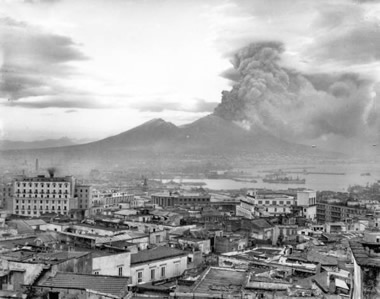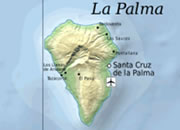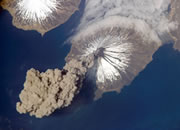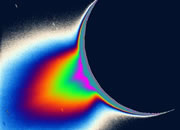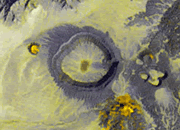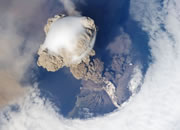Home » Volcanoes » Mount Vesuvius
Mount Vesuvius - Italy
Article by Jessica Ball
| Picture of Mount Vesuvius and Naples Bay |
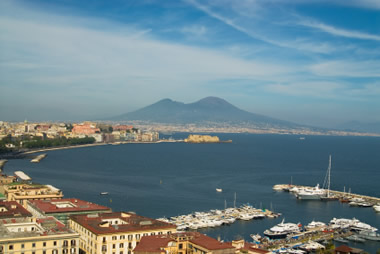
A panorama of the Gulf of Naples, Italy, showing the high population density and commerce. Mt. Vesuvius rests quietly in the background. Image copyright iStockphoto / Danilo Ascione.
Mount Vesuvius Introduction
Vesuvius is the only active volcano in mainland Europe, and has produced some of the continent's largest volcanic eruptions. Located on Italy's west coast, it overlooks the Bay and City of Naples and sits in the crater of the ancient Somma volcano. Vesuvius is most famous for the 79 AD eruption which destroyed the Roman cities of Pompeii and Herculaneum. Though the volcano's last eruption was in 1944, it still represents a great danger to the cities that surround it, especially the busy metropolis of Naples.
| Simplified plate tectonics cross-section |
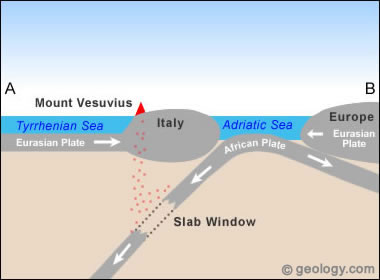
Simplified plate tectonics cross-section showing how Mount Vesuvius is located above a subduction zone formed where the African plate descends beneath Italy. Magma produced from the melting African plate creates the large, violently explosive volcanoes of the Italian Peninsula.

Map showing the location of Mount Vesuvius on the west coast of Italy. Map by Geology.com and MapResources.
Nearby Volcanoes: Etna, Stromboli
Mount Vesuvius: Plate Tectonic Setting
Vesuvius is part of the Campanian volcanic arc, a line of volcanoes that formed over a subduction zone created by the convergence of the African and Eurasian plates. This subduction zone stretches the length of the Italian peninsula, and is also the source of other volcanoes like Mount Etna, the Phlegraean Fields (Campi Flegrei), Vulcano, and Stromboli. Under Vesuvius, the lower part of the subducting slab has torn and detached from the upper part to form what is called a "slab window." This makes Vesuvius' rocks slightly different chemically from the rocks erupted from the other Campanian volcanoes.
| Plaster casts: Victims of the 79 A.D. eruption |

Plaster casts of people who died in the city of Pompeii during the 79 AD eruption of Mount Vesuvius. They were buried by the ashfall. Image: Garden of the Fugitives. This photo was taken by Lancevortex and is distributed under a GNU Free Documentation License.
Mount Vesuvius Geology and Hazards
The cone known as Mount Vesuvius began growing in the caldera of the Mount Somma volcano, which last erupted about 17,000 years ago. Most rocks erupted from Vesuvius are andesite, an intermediate volcanic rock (about 53-63% silica). Andesite lava creates explosive eruptions on a variety of scales, which makes Vesuvius an especially dangerous and unpredictable volcano.
Strombolian eruptions (explosions of magma from a pool in the volcano's conduit) and lava flows from the summit and flank fissures are relatively small. Plinian eruptions (huge explosions that create columns of gas, ash and rock which can rise dozens of kilometers into the atmosphere) have a much greater reach, and have destroyed entire ancient cities near Vesuvius with huge ashfalls and pyroclastic flows. Vesuvius is currently quiet, with only minor seismic (earthquake) activity and outgassing from fumaroles in its summit crater, but more violent activity could resume in the future.
| Ruins at the ancient city of Pompeii |
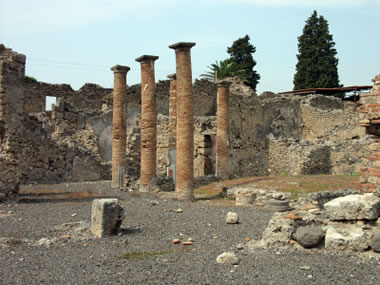
Brick columns stand among ruins of the ancient city of Pompeii. Image copyright iStockphoto / Evgeny Bortnikov.
The 79 AD eruption of Vesuvius is why volcanologists use "Plinian" to describe large volcanic eruption clouds. Pliny the Younger, a Roman historian who witnessed the 79 AD eruption, wrote the oldest surviving description of the tall, tree-shaped cloud that rose above the volcano. Modern volcanologists use the term to describe large-volume, violent eruptions that produce quickly-expanding clouds of rock, ash and gases which rise many miles into the atmosphere. Some more recent examples of Plinian eruptions include Mount St. Helens in 1980 and Pinatubo in 1990. Here is Pliny's description...
"On 24 August, in the early afternoon, my mother drew [my uncle's] attention to a cloud of unusual size and appearance. Its general appearance can be best expressed as being like an umbrella pine, for it rose to a great height on a sort of trunk and then split off into branches, I imagine because it was thrust upwards by the first blast and then left unsupported as the pressure subsided, or else it was borne down by its own weight so that it spread out and gradually dispersed. Sometimes it looked white, sometimes blotched and dirty, according to the amount of soil and ashes it carried with it."
|
Mount Vesuvius: Eruption History
Mount Vesuvius has experienced eight major eruptions in the last 17,000 years. The 79 AD eruption is one of the most well-known ancient eruptions in the world, and may have killed more than 16,000 people. Ash, mud and rocks from this eruption buried the cities of Pompeii and Herculaneum. Pompeii is famous for the casts the hot ash formed around victims of the eruptions. The unfortunate people suffocated on ash in the air, which then covered them and preserved amazing details of their clothing and faces.
Facts About Mount Vesuvius |
| Location: |
West coast of Italy |
| Coordinates: |
40°49′ N 14°26′ E |
| Elevation: |
1,281 m (4,000 feet) |
| Volcano Type: |
Complex |
| Last Eruption: |
1944 |
| Nearby Volcanoes: |
Etna Stromboli |
|
Starting in 1631, Vesuvius entered a period of steady volcanic activity, including lava flows and eruptions of ash and mud. Violent eruptions in the late 1700s, 1800s and early 1900s created more fissures, lava flows, and ash-and-gas explosions. These damaged or destroyed many towns around the volcano, and sometimes killed people; the eruption of 1906 had more than 100 casualties. The most recent eruption was in 1944 during World War II. It caused major problems for the newly-arrived Allied forces in Italy when ash and rocks from the eruption destroyed planes and forced evacuations at a nearby airbase.
ADVERTISEMENT
| More Vesuvius Information |
Smithsonian Institution Global Volcanism Program Website: Vesuvius page.
Gates, A.E. and Ritchie, D., 2007, Encyclopedia of Earthquakes and Volcanoes, Third Edition: New York, NY, Checkmark Books, 346 p.
Osservatorio Vesuviano (Vesuvius Observatory), Istituto Nazionale di Geofisica e Vulcanologia.
Wortel, M.J.R. and Spakman, W., 2000, Subduction and Slab Detachment in the Mediterranean-Carpathian Region: Science, v. 290, n. 5498, p. 1910-1917. Review (full text upon subscription).
The Letters of Pliny the Younger, Penguin Classics (translated by Betty Radice).
|
About the Author
Jessica Ball is a graduate student in the Department of Geology at the State University of New York at Buffalo. Her concentration is in volcanology, and she is currently researching lava dome collapses and pyroclastic flows. Jessica earned her Bachelor of Science degree from the College of William and Mary, and worked for a year at the American Geological Institute in the Education/Outreach Program. She also writes the Magma Cum Laude blog, and in what spare time she has left, she enjoys rock climbing and playing various stringed instruments.

Find Other Topics on Geology.com:
 | Rocks: Galleries of igneous, sedimentary and metamorphic rock photos with descriptions. |
|
 | Minerals: Information about ore minerals, gem materials and rock-forming minerals. |
|
 | Volcanoes: Articles about volcanoes, volcanic hazards and eruptions past and present. |
|
 | Gemstones: Colorful images and articles about diamonds and colored stones. |
|
 | General Geology: Articles about geysers, maars, deltas, rifts, salt domes, water, and much more! |
|
 | Geology Store: Hammers, field bags, hand lenses, maps, books, hardness picks, gold pans. |
|

|
 | Diamonds: Learn about the properties of diamond, its many uses, and diamond discoveries.
|
|




